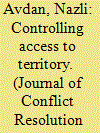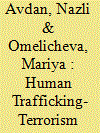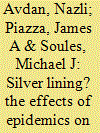|
|
|
Sort Order |
|
|
|
Items / Page
|
|
|
|
|
|
|
| Srl | Item |
| 1 |
ID:
190835


|
|
|
|
|
| Summary/Abstract |
Much ado has been made about the specter of unconventional weapons in the hands of militant groups. Despite the alarmism of the policy community, the pursuit of chemical, biological, radiological, and nuclear capabilities by non-state actors is rare. What explains why some violent non-state organizations pursue chemical, biological, radiological, and nuclear weapons while most do not? Using new data on organizational behaviors and attributes from the Big Allied and Dangerous 2 Insurgency project, we analyze 140 insurgent actors, from 1998 to 2012. We expand previous work by Asal, Ackerman & Rethemeyer by studying the phenomenon longitudinally and attending to organizational behavior rather than only to structural and environmental factors. We find that organizations that attack cultural sites are more likely to pursue and use chemical, biological, radiological, and nuclear weapons. We interpret the latter as a willingness to transgress upon accepted mores, for the sake of sensationalism and shock value, which coheres with a willingness to pursue unconventional weapons. Our results reflect that chemical, biological, radiological, and nuclear pursuit and use is part of a larger strategy for some violent non-state organizations, one predicated on generating mass fear and exacting a psychological toll.
|
|
|
|
|
|
|
|
|
|
|
|
|
|
|
|
| 2 |
ID:
132321


|
|
|
|
|
| Publication |
2014.
|
| Summary/Abstract |
Previous scholarship has largely failed to address the effect of economic interdependence on issue areas other than interstate conflict. This study seeks to redress this lacuna by focusing on states' visa policies and examining the impact of trade and capital interdependence in the context of transnational terrorism. The article argues that economic ties affect visa policies through a reconfiguration of preferences and the opportunity costs of economic loss and by tempering the impact of terrorism. To support this claim, the study conducts statistical analysis using directed dyad data on the visa policies of 207 states and independent political units. The article shows that the impact of economic interdependence is contingent on whether states are directly targeted in attacks of terrorism or face indirect threats from global terror. The study finds that economic incentives overwhelm security concerns when threats are indirect but have relatively limited influence, given threats against a state's own citizens or territory.
|
|
|
|
|
|
|
|
|
|
|
|
|
|
|
|
| 3 |
ID:
153906


|
|
|
|
|
| Summary/Abstract |
States traditionally build walls to repel the armies of adversaries and consolidate control over territory. More recently, the growth in violence by nonstate groups has led governments to use fences to prevent insurgent activity and transnational terrorism. This practice, which has accelerated since the end of World War II, challenges liberal expectations of a borderless world. We use a new and unique data set on twentieth century interstate border barriers to evaluate the effectiveness of fencing as a defense against transnational terrorist attacks. The strategic nature of barrier construction makes the assessment of causal effects complex. However, our analyses suggest that fences reduce the annual relative risk of a terrorist attack by at least 67 percent. Much of the literature on transnational terrorism focuses on variables such as democracy, development, and distance—that is, factors that are difficult for policy-makers to manipulate. But our analysis suggests that fencing may provide an effective policy tool for leaders seeking to insulate their states from transnational terrorist attacks.
|
|
|
|
|
|
|
|
|
|
|
|
|
|
|
|
| 4 |
ID:
181165


|
|
|
|
|
| Summary/Abstract |
Why do some militant organizations participate in human trafficking? We investigate this question by introducing a new dataset that records insurgent organizations’ involvement in four types of human trafficking: sexual exploitation, forced recruitment, slavery, and kidnapping. Marrying our data to the BAAD2I population of insurgent organizations, we uncover the organizational attributes related to human trafficking. We find that groups with wide alliance networks and territorial control are more likely to commit human trafficking. Organizations that are losing command of the territory and suffering rank-and-file losses are also more likely to turn to human trafficking. Our study sheds theoretical light on insurgent groups’ involvement in crime. It also contributes to the empirical scholarship on sexual violence by violent groups by studying different forms of human trafficking in both conflict and non-conflict environments. Our paper presents an original dataset and empirical analysis of insurgent groups’ human trafficking patterns.
|
|
|
|
|
|
|
|
|
|
|
|
|
|
|
|
| 5 |
ID:
191050


|
|
|
|
|
| Summary/Abstract |
In this study we examine the effects of epidemics on terrorist groups’ attack capacities. We consider two theoretical relationships between epidemics and terrorist groups. By weakening government counterterrorism defenses and increasing popular grievances, epidemics can provide a strategic environment that is conducive to terrorist groups, enhancing their capacity to commit more attacks, yield higher casualties and launch more logistically complex attacks. Conversely, epidemics can impair the abilities of terrorist groups to launch attacks by eroding group capacity and access to resources while incentivizing the state to increase its surveillance and policing capabilities. We test these two competing arguments using a database of over 620 terrorist groups for the period of 1970 to 2016. Our findings support the second argument. Terrorist groups based or operating in countries experiencing more and more intense epidemics commit fewer attacks, generally produce fewer casualties, commit a lower ratio of transnational to domestic attacks and less frequently use multi-mode attacks. We conclude with a discussion of the implications of these findings.
|
|
|
|
|
|
|
|
|
|
|
|
|
|
|
|
| 6 |
ID:
156618


|
|
|
|
|
| Summary/Abstract |
Scholarship explores the impact of human rights abuse and state repression on terrorism. Heretofore, scholarship has ignored the impact of government-sponsored killings on domestic terrorism. This article proposes that mass killings create a focal point for terrorist mobilization. The vendetta agenda fuels violence by animating retributory violence. Additionally, mass atrocities create a permissive environment for violent nonstate activity. A spiral of violence ensues whereby groups resort to terrorism. Utilizing data from the Global Terrorism Database, 1971–2011, the study shows that mass killings significantly increase domestic terrorism. It contributes to emerging scholarship examining how state policies influence terrorist activity.
|
|
|
|
|
|
|
|
|
|
|
|
|
|
|
|
|
|
|
|
|